
V Corps, formerly known as the Fifth Corps, is a regular corps of the United States Army headquartered at Fort Knox, Kentucky and Camp Kościuszko, Poland.
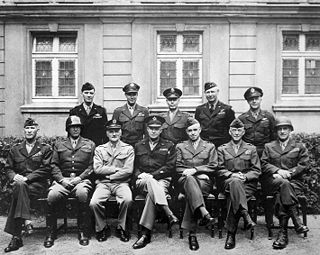
The European Theater of Operations, United States Army (ETOUSA) was a theater of Operations responsible for directing United States Army operations throughout the European theatre of World War II, from 1942 to 1945. It commanded Army Ground Forces (AGF), United States Army Air Forces (USAAF), and Army Service Forces (ASF) operations north of Italy and the Mediterranean coast. It was bordered to the south by the North African Theater of Operations, United States Army (NATOUSA), which later became the Mediterranean Theater of Operations, United States Army (MTOUSA).
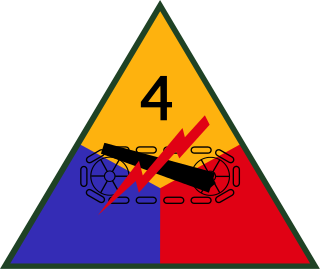
The 4th Armored Division was an armored division of the United States Army that earned distinction while spearheading General Patton's Third Army in the European theater of World War II.

General Lucian King Truscott Jr. was a highly decorated senior United States Army officer, who saw distinguished active service during World War II. Between 1943–1945, he successively commanded the 3rd Infantry Division, VI Corps, Fifteenth Army and Fifth Army, serving mainly in the Mediterranean Theater of Operations (MTO) during his wartime service. He and Alexander Patch were the only U.S. Army officers to command a division, a corps, and a field army in combat during the war.

The II Corps was a corps-sized formation of the United States Army that was active in both World War I and World War II. It was originally formed and fought on the Western Front during World War I and was also the first American formation of any size to see combat in North Africa or Europe during World War II.
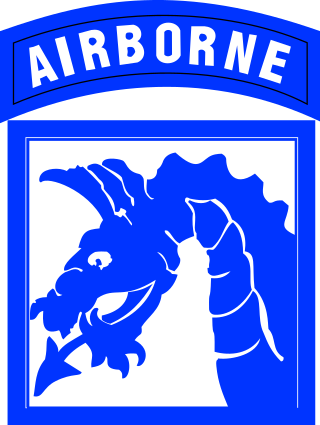
The XVIII Airborne Corps is a corps of the United States Army that has been in existence since 1942 and saw extensive service during World War II. The corps is designed for rapid deployment anywhere in the world and is referred to as "America's Contingency Corps." Its headquarters are at Fort Liberty, North Carolina.

The 2nd Armored Division was an armored division of the United States Army. The division played important roles during World War II in the invasions of Germany, North Africa, and Sicily and in the liberation of France, Belgium, and the Netherlands. During the Cold War, the division was primarily based at Fort Hood, Texas, and had a reinforced brigade forward stationed in Garlstedt, West Germany. After participation in the Persian Gulf War, the division was inactivated in 1995.

The VII Army Corps of the United States Army was one of the two principal corps of the United States Army Europe during the Cold War. Activated in 1918 for World War I, it was reactivated for World War II and again during the Cold War. During both World War II and the Cold War it was subordinate to the Seventh Army, or USAREUR and was headquartered at Kelley Barracks in Stuttgart, West Germany, from 1951 until it was redeployed to the US after significant success in the Gulf War in 1991, then inactivated in 1992.

The 15th Army Group was an army group in World War II, composed of the British Eighth Army and initially the Seventh United States Army (1943), replaced by the Fifth United States Army, which apart from units from across the British Empire and United States, also had entire units from other allied countries/regions, including: one corps from Free France and one from Poland; one division from Brazil; multiple separate brigades of Italians and Greeks; plus support to, and from, local Italian partisans. It operated in the Italian Campaign from 1943 to 1945.
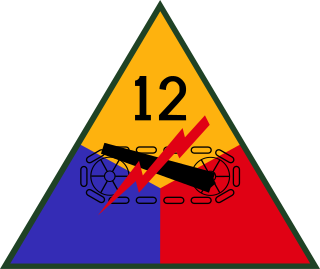
The 12th Armored Division was an armored division of the United States Army in World War II. It fought in the European Theater of Operations in France, Germany and Austria, between November 1944 and May 1945.

First Army is the oldest and longest-established field army of the United States Army. It served as a theater army, having seen service in both World War I and World War II, and supplied the US army with soldiers and equipment during the Korean War and the Vietnam War under some of the most famous and distinguished officers of the U.S. Army. It now serves as a mobilization, readiness and training command.

The 6th United States Army Group was an Allied army group that fought in the European Theater of Operations during World War II. Made up of field armies from both the United States Army and the French Army, it fought in France, Germany, Austria, and, briefly, Italy. Also referred to as the Southern Group of Armies, it was established in July 1944 and commanded throughout its duration by General Jacob L. Devers.

General Alexander McCarrell Patch was a senior United States Army officer who fought in both world wars, rising to rank of general. During World War II, he commanded U.S. Army and Marine Corps forces during the Guadalcanal Campaign in the Pacific, and the Seventh Army on the Western Front in Europe.
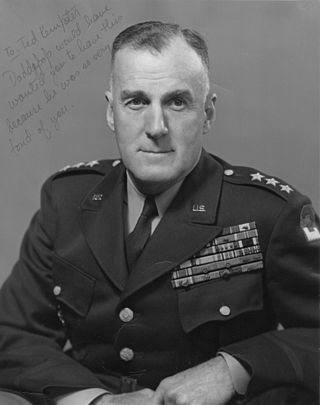
Lieutenant General Edward Hale Brooks was a highly decorated senior officer of the United States Army, a veteran of both World War I and World War II, who commanded the U.S. Second Army during the Korean War. He received the Distinguished Service Cross (DSC) for heroism as a junior officer in World War I and, remaining in the army during the interwar period, rose to command the 2nd Armored Division during the Battle of Normandy as well as VI Corps during the subsequent defeat of German forces in World War II.

The United States Army North (ARNORTH) is a formation of the United States Army. An Army Service Component Command (ASCC) subordinate to United States Northern Command (NORTHCOM), ARNORTH is the joint force land component of NORTHCOM. ARNORTH is responsible for homeland defense and defense support of civil authorities. ARNORTH is headquartered at Fort Sam Houston, Texas. Redesignated ARNORTH in 2004, it was first activated in early January 1943 as the United States Fifth Army, under the command of Lieutenant General Mark W. Clark.

Lieutenant General Willis Dale Crittenberger was a senior officer of the United States Army. He was a career soldier who served with distinction during the Italian campaign of World War II

The United States Army Central, formerly the Third United States Army, commonly referred to as the Third Army and as ARCENT, is a military formation of the United States Army that saw service in World War I and World War II, in the 1991 Gulf War, and in the coalition occupation of Iraq. It is best known for its campaigns in World War II under the command of General George S. Patton.

Major General Roderick Random Allen was a senior United States Army officer, who commanded the 20th and 12th Armored Divisions during World War II. Under his command of the 12th AD, the division defended Strasbourg from recapture; it provided the armored contingent in the closure of the Colmar Pocket and the liberation of Colmar; it spearheaded General George Patton's drive to the Rhine; captured intact the remaining bridge over the Danube River and broke the German defense line; and played a major part in blocking the Brenner Pass, thereby trapping over a million German soldiers in Italy as the war ended. En route to the Brenner Pass it overran eleven concentration camps at Landsberg, Germany.
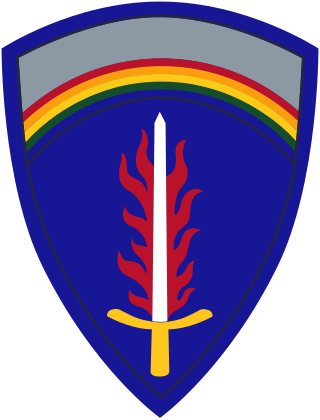
United States Army Europe and Africa (USAREUR-AF) is an Army Service Component Command (ASCC) /Theater Army responsible for directing United States Army operations throughout the U.S. European Command (EUCOM) and U.S. Africa Command (AFRICOM) area of responsibility.
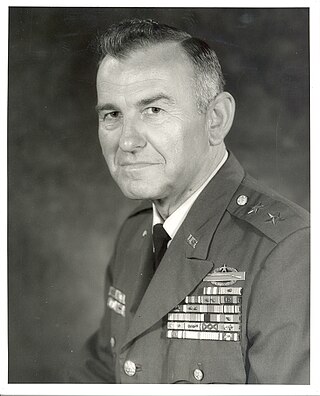
Robert Leahy Fair was a United States Army lieutenant general and a field commander in Germany during the Cold War. Fair commanded V Corps from August 25, 1975, until January 4, 1976. After 32 years in the U.S. Army and service in three wars, Fair concluded his career in 1976, and died in 1983.
























